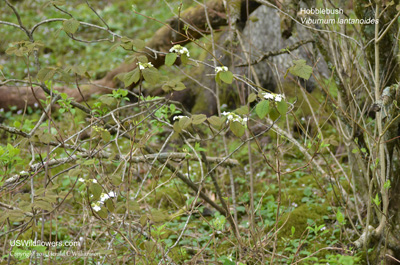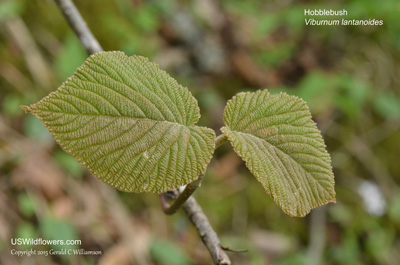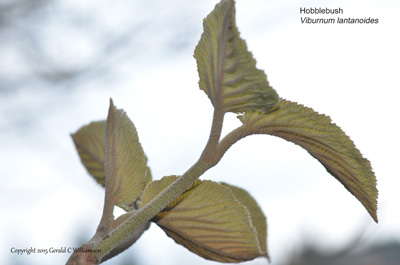Wildflowers of the United States | |||||||||||||
| |||||||||||||
Viburnum lantanoides - Hobblebush, Witch Hobble, Hobbleberry. Viburnum is a large genus in the Adoxaceae (Muskroot) family (formerly Caprifoliaceae), with 150 to 200 species worldwide - mostly in Asia and South America, but with 30 to 35 found in the wild in the United States. There are also a number of cultivars - think Snowball Bush. I most frequently confuse Viburnum with Hydrangea, although they are not closely related, probably because some species of both plants may have larger, sterile flowers around the outside of the inflorescence. The flowers of Viburnum will normally have 5 stamens, while those of Hydrangea will have 8 to 10. Both Viburnums and Hydrangeas normally appear as shrubs or small trees.
| Viburnum lantanoides is a plant that prefers cool, moist places, found primarily in the northeastern United States and southeastern Canada, but also found into the southeastern United States in the upper elevations of the Appalachian Mountains. The photos on this page were taken at an elevation of over 4,000 feet in the Great Smoky Mountains National Park. Found in: CT, GA, MA, MD, ME, NC, NH, NJ, NY, OH, PA, RI, TN, VA, VT, WV Leave comments on Viburnum lantanoides at this link.   Blue=Native; Grey=Introduced Map from USDA Plants Database: USDA, NRCS. 2017. The PLANTS Database (http://plants.usda.gov, 03 Jun 2025). National Plant Data Team, Greensboro, NC 27401-4901 USA. Search Our Database: Enter any portion of the Scientific, Common Name, or both. Do a general Google search of the entire site: #ad
| #ad
| | ||||||||||
|
Commercial / Cookie Notice Looking for Wildflowers for a specific state? Check here: | |||||||||||||
|
| |||||||||||||




